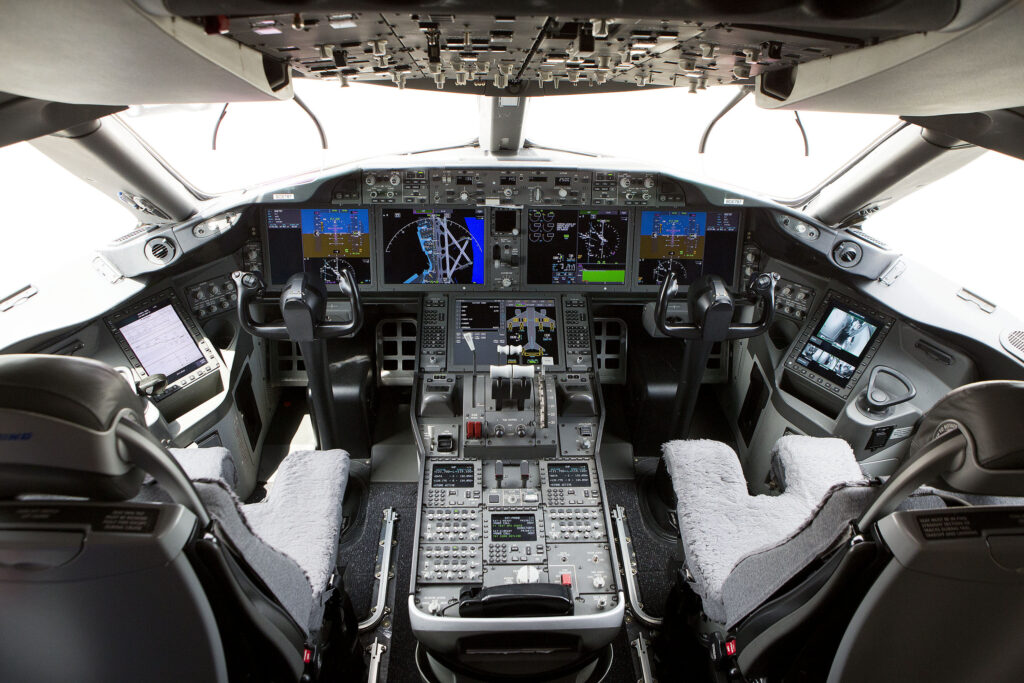OPINION: Exploring the Feasibility of Single-Pilot Flight Decks


This article explores the feasibility of single-pilot flight decks and whether avionics are the solution. It is contributed by Vance Hilderman, aviation expert, author, and CEO of AFuzion. (Photo: Joshua Roberts/Bloomberg)
Airlines may be taking to the skies, but their profit margins haven’t. Many have failed to recoup their pandemic losses, while simultaneously struggling to cope with higher fuel prices. So predictably, airlines are now exploring another round of cost-cutting measures. They’ve slashed away perks, reduced seat size, and taken away meals. But their latest focus? Reducing the number of pilots.
How did we get to this point? In the beginning days of commercial aviation, flights were manned by five crew members in the cockpit. However, for quite a while now the norm has been two: the captain and the first officer, more commonly referred to as the co-pilot. Airlines are now rapidly looking to eliminate the latter in a push for single-pilot operations (SPO). In fact, leading aircraft manufacturers including Airbus are actively pursuing artificial intelligence-based options to promote single-pilot and even “no-pilot” (e.g. an incapacitated single pilot); this means the onboard avionics systems take over all operations including communicating to air traffic control through a safe autonomous landing.
Airlines argue that, with the assistance of advanced AI technologies, one pilot is completely adequate; pilot unions, meanwhile, have vehemently disagreed. Either way, the argument for single-pilot flight decks hinges entirely on avionics: the technology on an aircraft that can be automated and take on the job of a co-pilot.
However, regulators are hesitant to approve the SPO concept, and, just recently, European policymakers ruled out the possibility of single-pilot flights in the near future. But as we know, Europe tends to be a much tighter regulatory environment in general. There is still the possibility that SPO might take off in the U.S., or in Asia’s fastest-growing sector of aviation, as both avionics and AI advance.
SPO challenges
The main idea behind two pilots is the principle of redundancy. If one person were to become incapacitated, say in a medical emergency, there is a backup. That’s what happened on a Southwest Airways flight from Las Vegas to Columbus when the pilot suddenly became ill, and the plane was then operated by the other pilot on board.
There is no regulating your way out of a heart attack—perhaps authorities could mandate more intensive and regular medical screenings for pilots—but there is not much that can be done for unpredictable health emergencies. What if it had been an SPO who had fallen ill? Although planes may be capable of cruising autonomously, they’re not yet able to land themselves.
The need for redundancy is not limited to just potential pilot incapacitation. Some stressful and challenging situations simply require multiple heads, and real co-pilots are often necessary to aid in potential emergencies. Consider how Capt. Chesley “Sully” Sullenberger—who performed an emergency landing on the Hudson River—has loudly protested against the single pilot push, arguing the so-called “Miracle on the Hudson” would’ve been the “Disaster on the Hudson” without two experienced pilots on board.
While AI can do what it’s programmed to do, it can’t contend with anything it hasn’t been specifically trained for. Moreover, it can’t weigh moral decisions: hit the cat or the child, as the old adage goes. Do or don’t turn on malfunctioning windshield wipers in the rain that may exacerbate an electronic failure. This lack of decision-making capabilities hinders AI’s potential as a co-pilot. You can automate tasks, but certain situations still need human oversight, and arguably an ethical code.
Necessary advancements in avionics
Airlines are currently experimenting with extended minimum crew operations (eMCO), which allows one pilot to exit the flight deck—on break—and leave the aircraft operated by the remaining pilot. This allows pilots to temporarily leave their station to attend to their physiological needs during an eMCO segment of the flight, while ensuring an acceptable level of safety and security.
But that differs from a single pilot operating the plane the whole way. We need to see the advancement of aircraft that are capable of being fully autonomous before we can see SPO implemented. At minimum, we need advances in aviation cruising that make it possible to leave the flight deck unattended for a short period of time.
While fully autonomous aircraft are already taking flight, especially electric vehicle take-off and landing (eVTOL) aircraft, they’re primarily for short distances and restricted to transporting fewer than five or six passengers. Long-haul autonomous commercial jets are at least two decades away, because autonomous flight systems are simply not yet on par with the flying capabilities of real pilots, especially with challenging large-scale aircraft.
Regulating our way out?
Before SPO can be even remotely feasible, there are various additional components that will require regulation, such as flight management systems (FMS). With FMS technology, pilots can automate flight planning and navigation tasks, calculate optimal routes, monitor fuel consumption, and manage the aircraft’s trajectory. Fortunately, new regulations such as the new SAE ARP4754B will greatly enable safe advance modeling of these critical avionics systems within future aircraft.
The FAA already has guidelines in place for the airworthiness approval of FMS, but they are merely guidelines, not regulations, and therefore not legally binding. However, if we are to see a shift to SPO, these guidelines will need to become mandates. FMS technology would need to be under significant regulatory scrutiny and subject to frequent tests to ensure such a system could safely and reliably navigate aircraft without human input.
Regulations have thus far not caught up with the stringency required to safely implement SPO, but airlines are evidently lobbying lawmakers in that direction. If the FAA were to get on board with developing regulations to govern SPO safely, it could become a real possibility. But avionics innovators and policymakers all need to contribute to the effort.

Vance Hilderman, aviation expert, author, and CEO of AFuzion
The post OPINION: Exploring the Feasibility of Single-Pilot Flight Decks appeared first on Avionics International.
—————
Boost Internet Speed–
Free Business Hosting–
Free Email Account–
Dropcatch–
Free Secure Email–
Secure Email–
Cheap VOIP Calls–
Free Hosting–
Boost Inflight Wifi–
Premium Domains–
Free Domains





